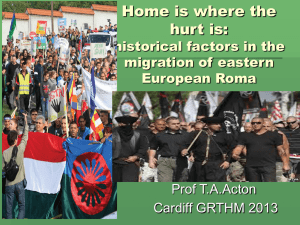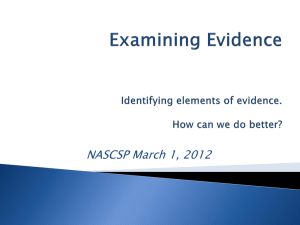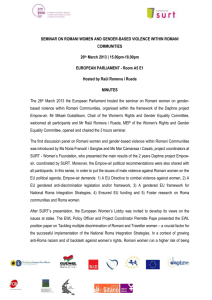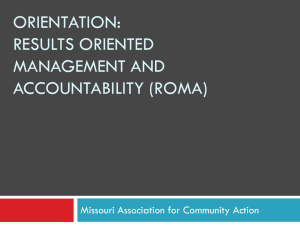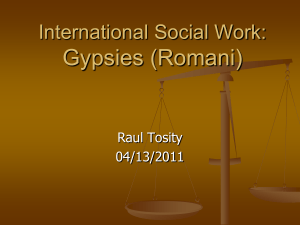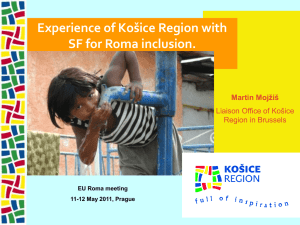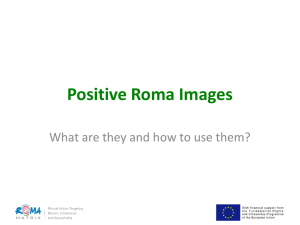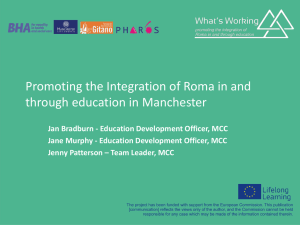Bild 1
advertisement
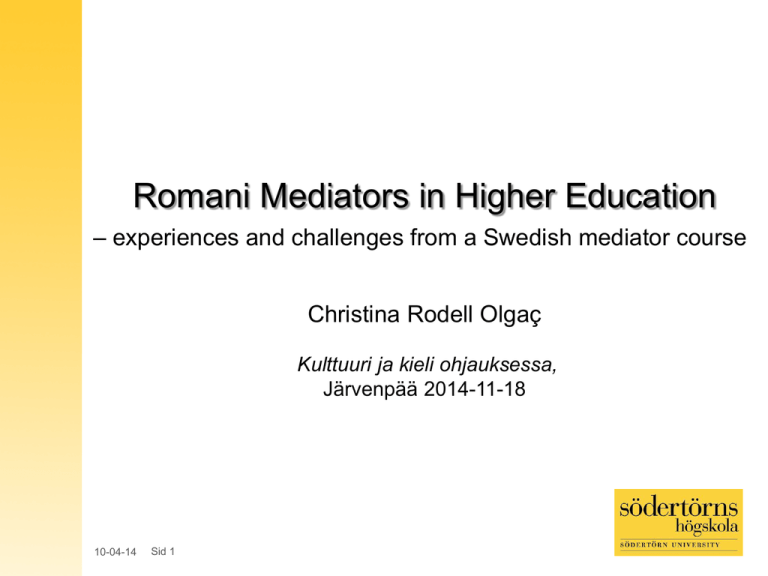
Romani Mediators in Higher Education – experiences and challenges from a Swedish mediator course Christina Rodell Olgaç Kulttuuri ja kieli ohjauksessa, Järvenpää 2014-11-18 10-04-14 Sid 1 500 years of Romani diversity in Sweden • • • • • • 10-04-14 The first written document concerning Roma in Sweden is from 1512. Many different groups have arrived during different historical periods (Kaale, Travellers, Kelderash, Lovara, Arlie etc.). Approximately 50 – 100 000 Roma living in Sweden. More than 20 varieties of Romani are spoken in the country. Many different religious beliefs represented among Roma i.e Catholics, Muslims, Lutherans, Pentecostals etc. In year 2000 Roma, Samis, Tornedalers, Swedish Finns and Jews were recognized as national minorities. Sid 2 The Strategy for Roma Inclusion 2012-2032 The overall goal of the 20-year strategy is that a Roma person who turns 20 years of age in 2032 is to have the same opportunities in life as a non-Roma. Five pilot municipalities will conduct development work between 2012 and 2015 in cooperation with relevant public authorities and Roma. The idea is to develop good examples of working methods that can be disseminated across the country. State measures in the pilot project include training of bridge builders, testing the use of health communicators, and increased knowledge of the extent to which support is given to Roma children in school. (www.government.se) 10-04-14 Sid 3 The school situation of Roma in five pilot municipalities – some results • • • • • • • 10-04-14 More Romani children attend pre-school, primary and secondary school are the main focus, attending upper secondary school is still not so common. The prevalence of low attendance among the children is emphasized in the interviews. Over–usage of placing Romani children in care seems to be frequent, and some of the parents seem to send their children to school out of fear of losing their children to the social welfare service. Post-traumatic stress disorders (PTSD) and secondary traumatisation among parents and children, especially from former Yugoslavia, are still prevalent and little support is given. Limited knowledge about the historical and contemporary situation of Roma among teachers and school staff. Many of the young drop-out adults are now much involved in the education of their own children. The parents wish to have a better home-school communication (Rodell Olgaç & Dimiter-Taikon, 2013). Sid 4 Theoretical perspectives Minority parents often face teachers in possession of the kind of symbolic capital, that is valued by the schools, thus favouring the knowledge and experience of the dominant social groups (Bourdieu, 1991; Bourdieu & Passeron, 1990; Lareau, 2003, Bouakaz, 2007). ”Schooling has become a crucial challenge, because illiteracy no longer serves to protect people or make them independent. Their changed circumstances, particularly their social and working lives, demand that Roma and Travellers adapt actively and rapidly – in order to go on living as Roma and Travellers – and that they adapt by using the tools provided by schooling (Liégeois, 2007: 175). 10-04-14 Sid 5 The mediator course The mediators are employed full time, mainly in schools, in their pilot municipalities during two years. Fifty percent of the time is devoted to the studies in the mediator course. Some of them have already been permanently employed. 30 credits divided into four independent courses of 7.5 credits: • Intercultural Perspectives on the History and Contemporary Situation of Roma and Travellers, 7.5 credits, spring 2013 • Intercultural Approach in Pre-school and Primary and Secondary School and the Mediator's Role regarding Roma, 7.5 credits, autumn 2013. • Children’s Language Socialisation and Learning from a Minorities Perspective, 7.5 credits, spring 2014 • Literacy and Learning from a Minority Perspective, 7.5 credits, autumn 2014 10-04-14 Sid 6 General course content • • • • • • • 10-04-14 Current research concerning the history and contemporary situation of Roma and Travellers, as well as for the four other national minorities (Sami, Tornedalers, Swedish Finns, Jews) in a school perspective. Communication and co-operation between home and school. The history of the Swedish school system, the current school system, an orientation concerning current curricula, syllabuses, grading system, and other central concepts and routines. Children’s language socialization and learning in a minority perspective, formal and informal learning, and the encounter between oral and literate traditions. The value system at school, Human Rights and how to challenge racism, discrimination and antiziganism in preschool and at school. An intercultural approach and intercultural communication at school. Training of study habits, generic competencies as co-operation capacities, literacy development and ICT. Sid 7 The organisation of the course • • • 2,5 days per month at the campus of Södertörn University with regular university as sessions, lectures etc. In between the campus stays - study of literature, preparation of assignments, group discussions, preparation of power point presentations etc. During 2013 one visit during 2,5 days to each pilot municipality with locally organized programme. Participants • 16 Participants, 6 women and 10 men, from the Arlie, Kaale, Kelderash and Lovara groups with mixed educational backgrounds. Teachers • one Romani, Angelina Dimiter-Taikon, and one non-Romani teacher, Christina Rodell Olgaç, working in tandem. 10-04-14 Sid 8 Questions - some examples from the mediators - 10-04-14 What issues do the mediators describe from their daily work as mediators in their municipalities? How do they describe their role as mediator? Do the mediators express any consequences for themselves in participating in the mediator course? Sid 9 Example 1 “Here [in this municipality] we are four persons working in schools as mediators. But we are all working in completely different ways and in four different schools. Mediator 1 works more deeply with the children through music (…). Mediator 2 works more with individual pupils in the school. (…) Mediator 3 has chosen another path. He is there before school starts and is checking the presence of the children. Then he brings some of the children to another classroom, where he has lessons, homework support etc. Mediator 4. I work in a different way from the other three. As you already know, I work in a school where they had Romani staff before. And it has not been easy. All the time, the school/the staff expects me to follow my predecessors ways. But I have not done this, instead I have tried to find my own ways and methods to reach out to the Romani children” (Male, second term). 10-04-14 Sid 10 Example 2 ”In connection with the teaching process, leisure time activities, and working with families I am: • working directly with the teachers and pupils; • communicating with children in their mother language; • providing specific cultural input; • supervising children during breaks; • attending teachers meetings; • using children’s natural openness to stimulate mutual understanding and appreciation of other cultures; • coordinating extra activities – school orchestra; • taking part in cultural happenings; • promoting positive social interaction; 10-04-14 Sid 11 • providing guidance and support for all these activities, and representing Romani culture; • organizing meetings and working with parents, to get them involved closely in the school process; • promoting tolerance and the overcoming of prejudice, as well as contacts between Romani and non-Romani parents and children; • mediating the special situations, that can appear in educational or family environment with calm, patience and tolerance; • work in team with school director, school staff and community representatives and facilitate communication between them” (Male, second term). 10-04-14 Sid 12 Example 3 ”I visit different pre-schools and schools where I hold lectures to the pupils and the staff about Romani history and culture, and tell them how it is to live [as a Romni] in today’s Sweden” (Female, first term). 10-04-14 Sid 13 Example 4 ”Romani mediators shall be a resource, a help to guarantee thorough understanding and support to those in need. The mediator is not and shall not be the solution of all problems in society, as it is impossible that such a big and wide question [the Romani issue] should only be promoted by the mediators’ resources. You have to be carful concerning this” (Female, second term). 10-04-14 Sid 14 Example 5 ”The mediators shall not help the Roma to adapt to the mainstream society, the mediator shall help to adapt the mainstream society in such way that the Roma also have a place in it” (Male, second term). 10-04-14 Sid 15 Preliminary results • • • • • • • 10-04-14 The Romani mediators play an important role for pupils, parents and staff and have in a very short time increased school attendance substantially. Disseminating more knowledge about the history and contemporary situation of Roma among teachers and school staff by the mediators result in more negotiations about different and flexible solutions concerning the school situation of the children. The mediators contribute to more dialogue and co-operation between parents and all the staff at school. The mediators contribute to organise extra activites for Romani children inside and outside the schools. They bridge between Romani children and other children. They contribute to a more intercultural approach at school in relation to the pupils and their families. The Romani mediators are seen as the solution of all problems of the Romani children at school, also structural problems, and their workloads are often very heavy. Sid 16 The indication is that the mediator course provides • • • • • • 10-04-14 increased knowledge about the history and contemporary situation of Roma and Travellers, and of the four other recognized national minorities in a school perspective. increased knowledge about the history of and the current school system, curricula, systems of assessment and other central concepts and routines at school as well as special education. increased knowledge and awareness about variations in children’s language socialization and learning in a minority perspective, formal and informal learning, and the encounter between oral and literacy traditions. improved generic competencies. an intercultural approach to different issues related to the school situation of Romani children. theoretical explanations and analytical tools of the mediatiors’ previous practical experiences and knowledge, and thus a strengthened role as a mediators. Sid 17 However, some of the mediators express that they cannot discuss the mediator course with their family and kin anymore, “because they will not understand what I am talking about” (Male, third term), The accumulation of symbolic capital, in this case higher education, and the social mobility that this may give, may have consequences for the mediators participating in the course, i.e. an increasing distance to other Roma in their own community. 10-04-14 Sid 18 Selected references Bourdieu, P. (1991). Kultur och kritik. Göteborg: Daidalos. Bourdieu, P. & Passeron, J.-C. (1990). Reproduction in Education, Society and Culture. London: Sage Publications. Bouakaz, L. (2007). Parental Involvement in School: What hinders and what promotes parental involvement in an urban school. Diss. University of Lund. Lareau, A. (2003). Unequal Childhoods: Class, Race, and Family Life. Berkley and Los Angeles: University of California Press. Liégeois, J.-P. (2007). Roma in Europe. Strasbourg: Council of Europe Publishing. Rodell Olgaç, C. (2013). Education of Roma in Sweden: an interplay between policy and practice. In S. Hornberg & C. Brüggemann (Hrsg.), Die Bildungssituation von Roma in Europa. Münster: Waxmann. Rodell Olgaç, Christina & Dimiter Taikon, Angelina 2013. ”Mamma, ska jag säga att jag är rom?” En kartläggning av romska barns och elevers skolsituation i fem pilotkommuner för Skolverket. Bilaga i Skolverkets Delredovisning av regeringsuppdrag inom regeringens strategi för romsk inkludering till Länsstyrelsen, Dn A2012/1387/DISK. SOU 2010:55. Romers rätt: en strategi för romer i Sverige. Betänkande av Delegationen för romska frågor. 10-04-14 Sid 19
